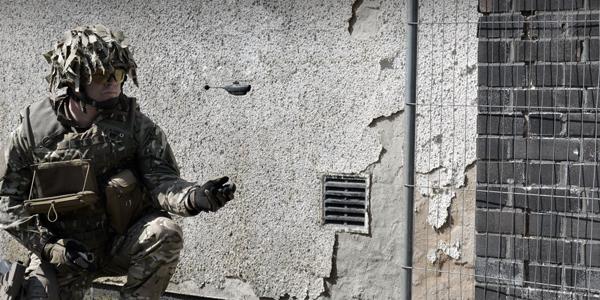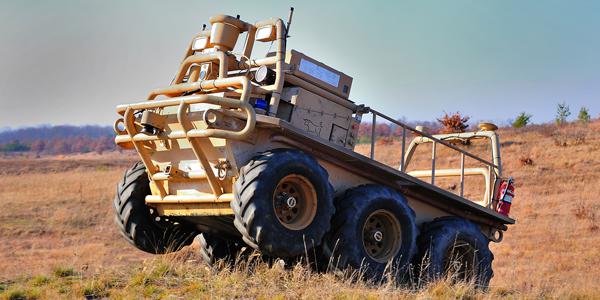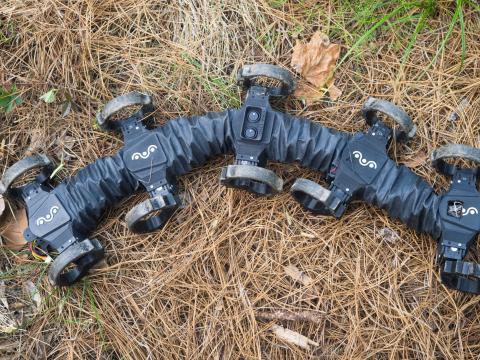Army Robotics Road Map Hits the Fast Lane
U.S. Army officials envision a future in which robots are integral members of the team performing a range of missions, whether hunting for roadside bombs, searching for threats inside buildings, lugging heavy equipment or packing heat in the form of a light machine gun or missile launcher for troop protection. The Army’s existing robotics road map is updated routinely, but now officials are looking for ways to realize their vision sooner than planned.
“We’ve been directed by the Department of the Army to try to speed up where we want to be in 2025, to add some robotic capability ahead of our current schedule,” reports Maj. Rod Secor, USA, deputy, Remote, Autonomous Systems Branch, U.S. Army Maneuver Center of Excellence, Fort Benning, Georgia. “We received that guidance in the fall from the chief of staff of the Army,” he adds, referring to Gen. Raymond Odierno.
Gen. Odierno’s guidance reflects the importance many service officials place on unmanned systems. “Robotics will have the biggest impact of any technology in the next 20 years on our warfighting units. We’ve been challenged by the Department of the Army to look for multiple ways that we can use today’s technology and push the boundaries of technology to benefit almost every echelon of the Army all the way down to the squad. The possibilities are limitless,” Maj. Secor declares. “We see it as a way to better protect soldiers and to augment some of our forces. Robotics is a combat multiplier for maneuver units.”
Keith Singleton, chief, unmanned systems team, Maneuver Battle Lab, Fort Benning, says the Army is developing a Robotics Enhancement Program to “try to keep pace with industry” by purchasing commercial off-the-shelf systems and placing them in the hands of soldiers for evaluation. Army documents found online indicate the Robotics Enhancement Program is intended to streamline the requirements process to “bridge the procurement gap.”
As a result of Gen. Odierno’s guidance, officials are questioning personnel and funding requirements and which systems can be fielded more quickly. “It will vary per system. There are some systems that have matured rather quickly,” Maj. Secor says. “You see children playing with quadcopters. That technology has expanded greatly and has become simpler and cheaper, and that’s something we could bring in earlier—maybe in the next couple of years.”
Many of the questions likely will be answered through an array of experiments being conducted at Fort Benning and elsewhere. The experiments help Army officials define concepts of operations and system requirements. This past November, for example, the maneuver center conducted a limited objective experiment, which included about 20 unmanned systems and related technologies. The experiment focused on manned-unmanned teaming, or the ability of unmanned systems to share information with one another and with soldiers on the ground.
The November event involved both near-term systems that could be fielded relatively quickly and midterm platforms that might take more development. Some of the systems included the Cargo Pocket Intelligence, Surveillance and Reconnaissance system, a pocket-sized helicopter; the M7 Spider Networked Munition, which is a hand-emplaced, remotely controlled, man-in-the-loop anti-personnel munition system; and the Remote Detection and Classification system, an early warning, intrusion-detection technology that provides live streaming video.
Army officials point out that not all systems involved in the experiments will be purchased and fielded. In fact, some simply act as surrogates for a future capability, with specific systems to be determined later. “We were putting those systems in a small unit and seeing how soldiers employed them and validating the concepts,” Singleton says. “Part of the concept is that future organizations are going to have these unmanned systems embedded in their formations. We’re validating concepts on how they will employ these types of systems.”
Many of the technologies in the November event also will be included in the Army’s next Network Integration Evaluation (NIE) conducted with the Brigade Modernization Command at Fort Bliss, Texas. “Their commanding general actually came for our visitor’s day when we did manned-unmanned ground, and he wants the concepts for some of those technologies that participated in ours to go and do a larger NIE event in the 2016 fiscal year,” Singleton says. “A lot of our experiments feed into those other experiments.”
Systems moving on to the NIE include the pocket-sized helicopter, an equipment hauler known as the Squad Multipurpose Equipment Transport and larger unmanned aerial vehicles, such as the Raven and Puma, which are programs of record. “There are some prototype systems or surrogate systems that will be participating. Some will have construction payloads, like backhoes or bulldozer types,” Singleton reports. “Some will have improvised explosive device-defeat and jammer technologies. They’ll also have some that will have remote weapon stations on them so you can mount a weapon and have a guy looking through some sort of optics and engage a target.”
The intent is for the unmanned platforms to connect through Nett Warrior, a situational awareness and mission command system for dismounted troops. “All the systems will hopefully be integrated with the end-user device currently being fielded, which is Nett Warrior, being able to provide that situation awareness to the leader from those sensors. We were able to demonstrate that, and the concept works. That was one of the highlights,” Singleton states.
The maneuver center also hosts annual Army Expeditionary Warrior Experiments (AEWE). Systems participating in this year’s AEWE include the TerraMax Route Clearance Unmanned Ground Vehicle; the Sky-Watch Huginn X1 Integrated Drone Recon System; the Saab Skeldar V-200; InstantEye, a small unmanned air system; the DP-12 Rhino Robotic Rotorcraft; and the Black Hornet Nano air vehicle, among others.
“The AEWE is the Army’s premier prototype live experimentation venue. AEWE is more of a technology-focused experiment where industry will bring their stuff in and get an early look at it with soldiers,” Singleton explains.
While many systems are proving their worth during experimentation, some challenges must be overcome before they can be fielded. “The network is the thing that really has to be developed,” Singleton reveals. “In order for us to maximize the use of these unmanned systems, there has to be a reliable and secure network to enable us to use these sensors to pass information on to leaders so they can make decisions.”
Additionally, some vehicles are not yet able to keep up with soldiers. “There are mobility concerns. Some of these systems can’t go where our soldiers go. We’re working through that. There are some challenges that have to be overcome before unmanned systems are a fully integrated member of the small unit,” Singleton offers.
The Army as a whole has many requirements for new unmanned systems, in addition to those already being used, such as Gray Eagle, Shadow, Raven and Puma, according to Maj. Secor. The maneuver center itself has requirements for four systems, including the Common Robotic System, a ground vehicle capable of carrying multiple payloads; the Squad Mission Equipment Transport for carrying equipment and easing the load soldiers carry; and the Light Reconnaissance Pod, a small ground vehicle capable of searching buildings, ductwork or even sewage systems. In addition, the center has a requirement for a pocket-sized, soldier-borne air system. “It looks like a children’s toy that can be in a squad leader’s pocket,” Maj. Secor offers.
“You can launch it over a hill or inside a building and around corners. It flies low to the ground and may not fly very long—just long enough that the squad leader can have a better visual so that he doesn’t have to put soldiers into a dangerous situation.”
The service also is exploring the possible use of armed ground robots. “These would be armed probably with a crew-served weapon like the M-240 or M-249,” Maj. Secor says, referring to two light machine gun models. “You could probably even use that for indirect fire, putting mortars or probably a multilaunch rocket system on a robot—always keeping a human in the loop before anything could be triggered.”
The robot, he explains, could be positioned to provide security on a formation’s flank, for example. It could be operated by a soldier safely located in the rear. “The armed robot is a big one that we see in the future,” Maj. Secor emphasizes.
In addition, Singleton stresses the need for a man in the loop if robots carry arms. “There has to be a man there somehow to make sure the robot doesn’t cause collateral damage or hurt civilians,” he adds.
Maneuver center officials also are interested in a ground system capable of carrying multiple payloads for different missions, including a full-motion video camera for surveillance; sensors for detecting chemical, biological or nuclear weapons; or a robotic arm for disposing of improvised explosive devices. “I see us using robotics for a lot of manned-unmanned teaming, a combination of robotics enhancing—not replacing, but enhancing—our capability with our regular soldiers,” Maj. Secor states.







Comments